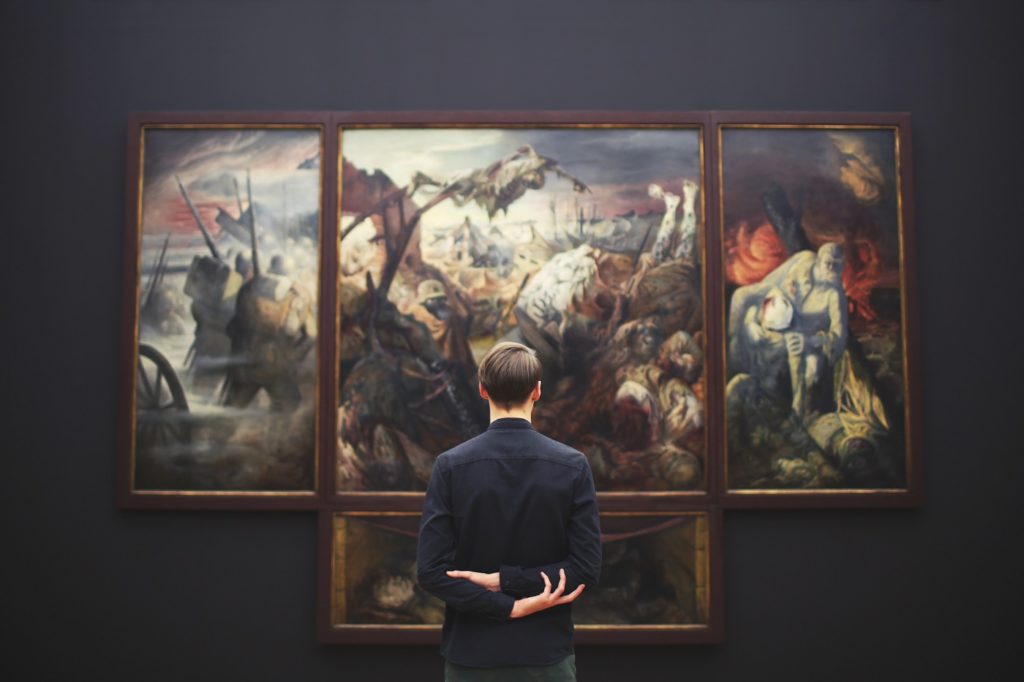Defenders of the liberal arts point to truth, goodness, and beauty as the noblest ends that make for a worthy life. There may have been times these were held in high cultural regard. Our era is not one of them.
Our era’s strongest challenge to truth comes not from relativism, but from quasi-religious faith in utilitarian pragmatism or almost theological pursuits in identity politics. Both utility and identity fragment our moral universe, but they do so on the basis of ironclad beliefs concerning the nature of reality. As a consequence, we retain all too little in the way of shared language that would help us navigate different competing views.
Walker Percy suggested that many words necessary for grappling with the deepest questions of meaning in life—such as sin, redemption, and love—eventually become worn out. How do we talk about these concepts if the words themselves cannot gain purchase in our neighbors’ minds? For the utilitarians, these are perhaps non-issues. Truth is what generates progress or cash value, and we ought to discard the rest. So, much of what passes for transformative truth these days flows from the Churches of the Woke in calls to redeem ourselves from social injustices, debts that can never quite be repaid. Neither of these, however, accepts the idea that there are distinctive moral truths around which human life ought to be ordered.
The idea of the good is intimately related to truth but deeply enmeshed with questions of character. But today a belief even in the possibility that there are things we can identify as good falls prey to cynicism. Culture reflects this. Across the dizzying variety of digital entertainment media, one constant holds: we live in the era of the “complex” protagonist, characters whose stories lean toward a kind of benevolent moral ambiguity at best. At worst, they advance the notion that only evil is interesting, while the good is either dull and boring or, worse, a mask for imposing our will on others.
Start your day with Public Discourse
Sign up and get our daily essays sent straight to your inbox.But it is no exaggeration to claim that in our culture, beauty suffers most of all. The loss of belief in truth and goodness leads to a sense that nothing is intrinsically worth our admiration or respect. Even those who still believe in truth and goodness may hold that beauty is entirely a matter of perspective. Defenders of the great books tend not to emphasize it much, struggling to articulate how beauty might relate to the rest of this endangered trio. They fail to recognize the ways that beauty might draw us into recognizing the truth about our existence, and from there to a realization of what moral goods might let us live well.
Beginning with Beauty
Intriguingly, and perhaps counter-intuitively, in his book Culture Care: Reconnecting with Beauty for our Common Life, Makoto Fujimura asserts that the path to restoring our belief in truth and goodness may depend on renewing our appreciation for beauty. He defines beauty as
the quality connected with those things that are in themselves appealing and desirable. Beautiful things are a delight to the senses, a pleasure to the mind, and a refreshment for the spirit. Beauty invites us in, capturing our attention and making us want to linger. Beautiful things are worth our scrutiny, rewarding to contemplate, deserving of pursuit. They inspire—or even demand—a response, whether sharing them in community or acting to extend their beauty into other spheres.
Fujimura aims at cultivating an outlook centered on reknitting our constantly fraying civic and social relationships. He believes that an artist’s mindset provides surprising insights into where we can recognize beauty, truth, and goodness in our lives—and through them, learn anew the art of living well.
In service of this view, Fujimura offers a metaphor for understanding how our everyday disasters might lead us into comprehending beauty. When the average citizen of a wealthy commercial society breaks a bowl, he or she sweeps up the pieces and throws them out. If the piece holds particularly great sentimental value, such a person might break out epoxy and mend it in such a way to look as if the accident had never happened. But who looks at the pieces and sees it as a chance to artistically mend the ceramic—to make the damage itself part of the art? In Japan, this is an art form known as kintsugi, and involves the use of silver, gold, or platinum compounds to bind together what was broken, and to find beauty in its restoration. Fujimura links kintsugi to a theological vision, one focused on redeeming the time God gives us by offering gratuitous beauty to enrich our common life.
While Fujimura clearly hopes to reach artists with this book, people from all walks of life ought to appreciate his vision. He writes for “anyone with a calling to create . . . Especially those with a desire or an artistic gift to reach across boundaries with understanding, reconciliation, and healing.” Fujimura views creativity as an act of stewardship: we cultivate, remake, and revive what has been inherited. This allows us to tell old stories anew and sing songs about the perennial cares of human life.
Beauty Combats Utilitarian Pragmatism
Fujimura helps us see why the culture’s profound resistance to beauty (to say nothing of truth and goodness) is actually a symptom of the American devotion to utilitarian pragmatism. Cost–benefit analysis suffuses all that we do.
Most of us recognize the shortcomings of reductionism at a deep level: we know that we are more than what we produce and that efficiency is not the point of education, religion, art, play, or many other aspects of human culture. Most people are dissatisfied with the reductionist viewpoint, yet not enough of us have or can articulate viable alternatives because reductionism has taken over not only how people define success but also what we value in society.
Utilitarian and pragmatic logic colonize our thinking to such a degree that even conscious efforts to override their influence often fail. We make judgments on the value of work this way all the time. (Consider how often stay-at-home moms are asked what they do, and how they feel pressured to answer, and you might have a sense of what I mean.) But more generally, this kind of evaluation forces us to define our actions down, to reduce them to instrumental terms. Such hollowed-out reasoning ultimately diminishes the value of life itself.
Where natural law philosophers and other opponents of these views make a good intellectual case against this logic, Fujimura proposes a somewhat different antidote. Human beings have a natural appreciation for beauty, but we strain to justify its existence in utilitarian or pragmatic terms. Fujimura argues that by offering an attractive vision, beauty makes the truths to which it relates appealing; it helps convince us that the good may not just be good for human life in the same way a healthy diet and exercise are, but also a source of joy.
Art and related acts of beauty offer a reminder of the really human things. In beauty’s absence, utility reigns. Pragmatism’s winnowing of our concerns to what works denies that we need beauty. Ideology’s tyranny of the present in the name of the future subordinates all human things to itself. Fujimura explains how these forces corrupted the practice of art:
When I began to exhibit in New York City in the mid-1990’s, “beauty” was taboo, not to be spoken of in public. It signified cultural hegemony, imperialist power, the corruption of the past, or the cosmetic sheen of superficial contemporary culture. The art world still resists this word.
Art has become distorted in attempts to avoid service to propaganda. Yet the resulting debasement of art offers nothing to the human heart to defend against ideology. Fujimura’s views on this point recall C.S. Lewis: “We castrate and bid the geldings be fruitful.”
Thankfully, because beauty is gratuitous, it naturally points beyond itself to truth and goodness—even when those who engage in acts of beauty disbelieve in them. Ultimately, Fujimura tells us, beauty intimates that there is more to life than what we can see. It directs our attention to God. Fujimura’s own story reflects this: he came to Christian faith in his years of graduate study in Japan as a result of his realization that he had no place in his heart on which to rest his love of beauty, and the beauty of the art he created. Thus began the long path of questioning that brought him to belief.
Tending a Garden, Not Fighting a War
Pressing artists and creatives into ideological service is clearly destructive. Witness the current woke-athon, which drains art of its appeal across our existing cultural borders and destroys the possibility of dialogue across the borders. Yet it is not just artists that need to hear Fujimura’s message and heed the call to rediscover the power of beauty.
Neither culture war nor cultural fortification allows us to engage in acts of restoration or persuasion.
Fujimura asks us all to consider what acts of culture will bear fruit. What will generate deeper community and renewed affection for our neighbors? He does not dispute that men and women of principle must stand for what they believe to be true, but suggests instead that we must remember that culture is not a field where victory is possible. Instead, it is a garden that requires tending.
Neither culture war nor cultural fortification allows us to engage in acts of restoration or persuasion. The culture wars offer nothing but a model of victory or defeat, and walling one’s family and children off from culture grows more difficult with every advance of technology. Fujimura believes that works of gratuitous beauty can bridge these gaps. Unexpected acts of care and love do as well.
Fujimura suggests that Christians in general and artists in particular serve in a particularly important role, which he calls “border-stalking.” Such people live and work at the margins of various groups, allowing them the possibility of negotiating and translating between them in ways that are impossible for the person who lives and works entirely in one sphere or milieu. This is an uncomfortable role, but a vital one: “Life on the borders of a group—and in the space between groups—is prone to dangers literal and figurative, with people both at home and among the ‘other’ likely to misunderstand or mistrust the motivations, piety, and loyalty of the border-stalker.” Their role is vital because artists can work to heal divisions, “overcoming caricatures and injecting diversity, nuance, and even paradox into the nature of the conversation, and then moving on to teach society a language of empathy and reconciliation.”
Fujimura is not overly sanguine about what it will take to rebuild our culture. He recognizes that cultural renewal will require a generational effort, and he makes practical suggestions for how communities, foundations, and churches can support the border-stalkers in their midst over the long term.
Fujimura offers us a way of thinking and speaking about beauty that might help restore civic friendship. In politics, there will always be winners and losers. Yet politics also retains a culture that must be tended to as well. The mores we display in culture spill over into politics, and our politics in turn shapes our varied cultures. If we do not tend the garden and stalk the borders, we risk finding ourselves to be aliens and strangers who are enacting a truce, not fellow citizens on our way home.













